CHEVROLET SUBURBAN 1997 Owners Manual
Manufacturer: CHEVROLET, Model Year: 1997, Model line: SUBURBAN, Model: CHEVROLET SUBURBAN 1997Pages: 433, PDF Size: 21.49 MB
Page 311 of 433
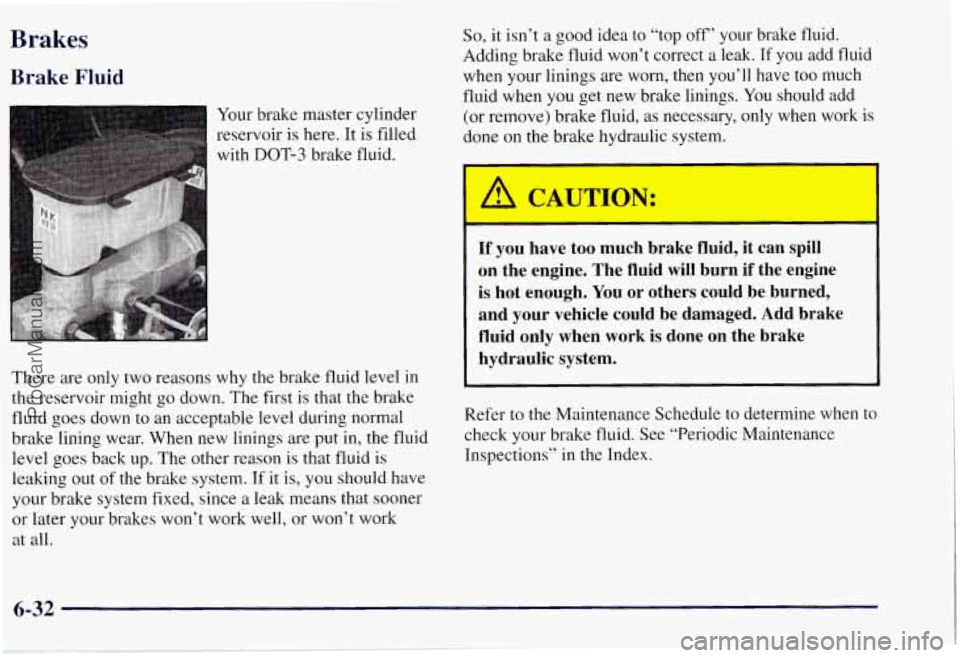
Brakes
Brake Fluid
Your brake master cylinder
reservoir
is here. It is filled
with DOT-3 brake fluid.
So, it isn’t a good idea to “top off’ your brake fluid.
Adding brake fluid won’t correct a leak.
If you add fluid
when your linings are worn, then you’ll have too much
fluid when you get new brake linings.
You should add
(or remove) brake fluid, as necessary, only when work is
done on the brake hydraulic system.
KCAUTION:
If you have too much brake fluid, it can spill
on the engine. The fluid
will burn if the engine
is hot enough.
You or others could be burned,
and your vehicle could be damaged. Add brake
fluid only when work is done on the brake
hydraulic system.
There are only two reasons why the brake fluid level in
the reservoir might go down. The first is that the brake
fluid goes down to an acceptable level during normal Refer to the Maintenance Schedule to determine when to
brake lining wear. When
new linings are put in, the fluid check your brake fluid. See “Periodic Maintenance
level goes back up. The other reason is that fluid is Inspections’’ in the Index.
leaking out of the brake system. If it is, you should have
your brake system fixed, since a leak means that sooner
or later your brakes won’t work well, or won’t work
at all.
6-32
ProCarManuals.com
Page 312 of 433
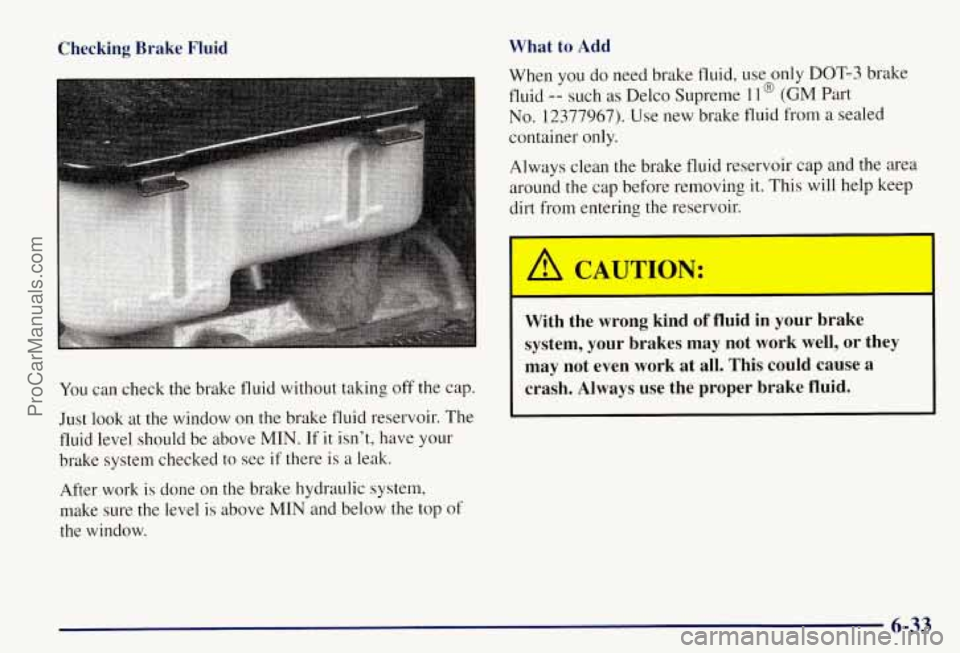
Checking Brake Fluid What to Add
You
can check the brake fluid without taking off the cap.
Just look at the window on the brake fluid reservoir. The
fluid level should be above MIN. If
it isn’t, have your
brake system checked to see if there is a leak.
After work
is done on the brake hydraulic system,
make sure the level is above MIN and below the top
of
the window. When
you do need brake fluid, use only DOT-3 brake
fluid
-- such as Delco Supreme 11 @ (GM Part
No. 12377967). Use new brake fluid from a sealed
container only.
Always clean the brake fluid reservoir cap and the area
around the cap before removing it. This will help keep
dirt from entering the reservoir.
With the wrong kind of fluid in your brake
system, your brakes may not work well, or they
may not even work at all. This could cause a crash. Always use the proper brake fluid.
-1
6-33
ProCarManuals.com
Page 313 of 433
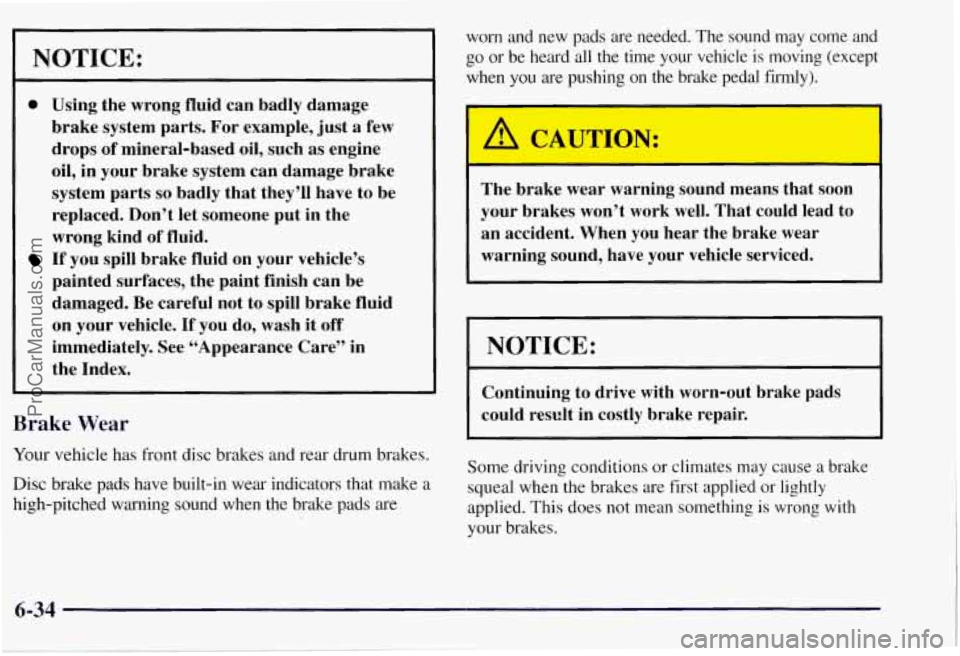
NOTICE:
0 Using the wrong fluid can badly damage
brake system parts. For example, just
a few
drops of mineral-based oil, such
as engine
oil, in your brake system can damage brake
system parts
so badly that they’ll have to be
replaced. Don’t let someone put in the
wrong kind of fluid.
If you spill brake fluid on your vehicle’s
painted surfaces, the paint finish can be
damaged. Be careful not to spill brake fluid
on your vehicle. If you do, wash it off
immediately. See “Appearance Care” in
the Index.
Brake Wear
worn and new pads are needed. The sound may come and
go or be heard all the time your vehicle is moving (except
when you are pushing on the brake pedal firmly).
I
The brake wear warning sound means that soon
your brakes won’t work well. That could lead to
an accident. When you hear the brake wear
warning sound, have your vehicle serviced.
I NOTICE:
r
Continuing to drive with worn-out brake pads
could result in costly brake repair.
Your vehicle has front disc brakes and rear drum brakes.
Disc brake pads have built-in wear indicators that make a
high-pitched warning sound when the brake pads are Some
driving conditions or climates may cause a brake
squeal when the brakes are first applied or lightly
applied. This does not mean something is wrong with
your brakes.
ProCarManuals.com
Page 314 of 433
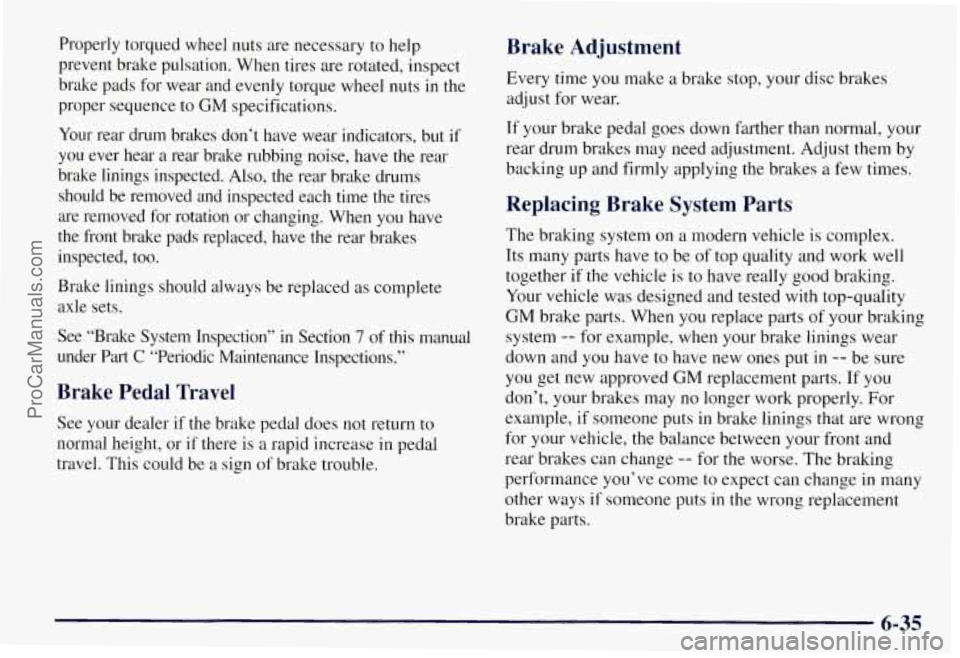
Properly torqued wheel nuts are necessary to help
prevent brake pulsation. When tires are rotated, inspect
brake pads for wear and
evenly torque wheel nuts in the
proper sequence to
GM specifications.
Your rear drum brakes don’t have wear indicators, but
if
you ever hear a rear brake rubbing noise, have the rear
brake linings inspected. Also, the rear brake drums
should be removed and inspected each time the tires
are removed for rotation or changing. When you have
the front brake pads replaced, have the rear brakes
inspected, too.
Brake linings should always be replaced
as complete
axle sets.
See “Brake System Inspection”
in Section 7 of this manual
under Part
C “Periodic Maintenance Inspections.’’
Brake Pedal Travel
See your dealer if the brake pedal does not return to
normal height, or
if there is a rapid increase in pedal
travel. This could be a sign
of brake trouble.
Brake Adjustment
Every time you make a brake stop, your disc brakes
adjust for wear.
If your brake pedal goes down farther than normal, your
rear drum brakes may need adjustment. Adjust them by
backing up and firmly applying the brakes
a few times.
Replacing Brake System Parts
The braking system on a modern vehicle is complex.
Its many parts have to be of top quality and work well
together if the vehicle is to have really good braking.
Your vehicle was designed and tested with top-quality
GM brake parts. When you replace parts of your braking
system
-- for example, when your brake linings wear
down and you have to have new ones put in
-- be sure
you get new approved
GM replacement parts. If you
don’t, your brakes may no longer work properly. For
example, if someone puts in brake linings that are wrong
for your vehicle, the balance between your front and
rear brakes can change
-- for the worse. The braking
performance you’ve come to expect can change in many
other ways if someone puts
in the wrong replacement
brake parts.
6-35
ProCarManuals.com
Page 315 of 433
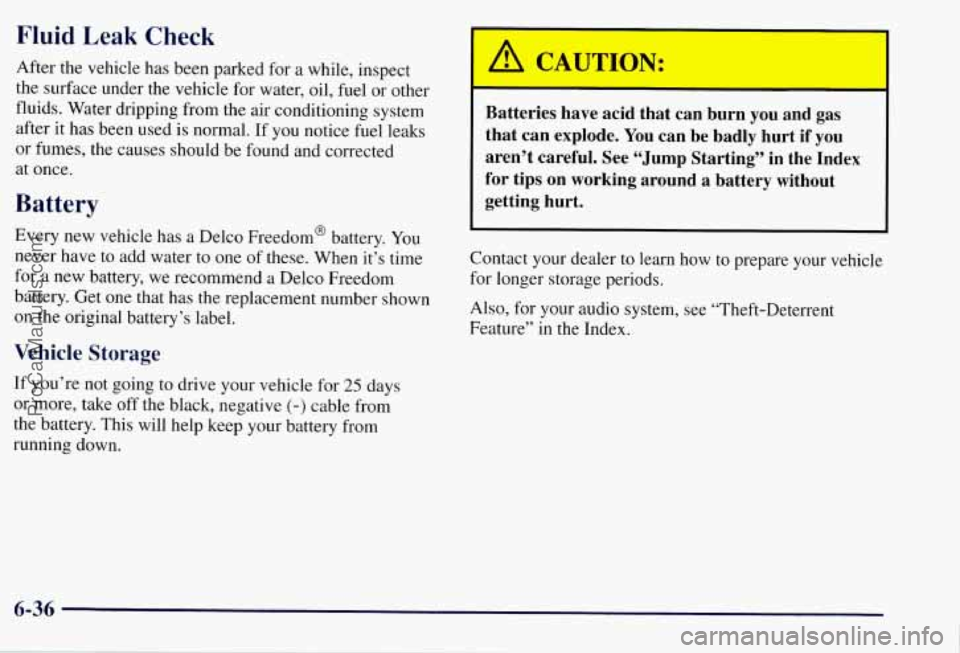
Fluid Leak Check
After the vehicle has been parked for a while, inspect
the surface under the vehicle for water, oil, fuel or other
fluids. Water dripping from the air conditioning system
after
it has been used is normal. If you notice fuel leaks
or fumes, the causes should be found and corrected
at once.
Battery
Every new vehicle has a Delco Freedom@ battery. You
never have to add water to one of these. When it’s time
for a new battery, we recommend a Delco Freedom
battery. Get one that has the replacement number shown
on the original battery’s label.
Vehicle Storage
If you’re not going to drive your vehicle for 25 days
or more, take off the black, negative
(-) cable from
the battery. This will help keep your battery from
running down.
/d CAUTION:
Batteries have acid that can burn you and gas
that can explode. You can be badly hurt if
you
aren’t careful. See “Jump Starting” in the Index
for tips on working around a battery without
getting hurt.
Contact your dealer to learn how to prepare your vehicle
for longer storage periods.
Also, for your audio system, see “Theft-Deterrent
Feature” in the Index.
6-36
ProCarManuals.com
Page 316 of 433
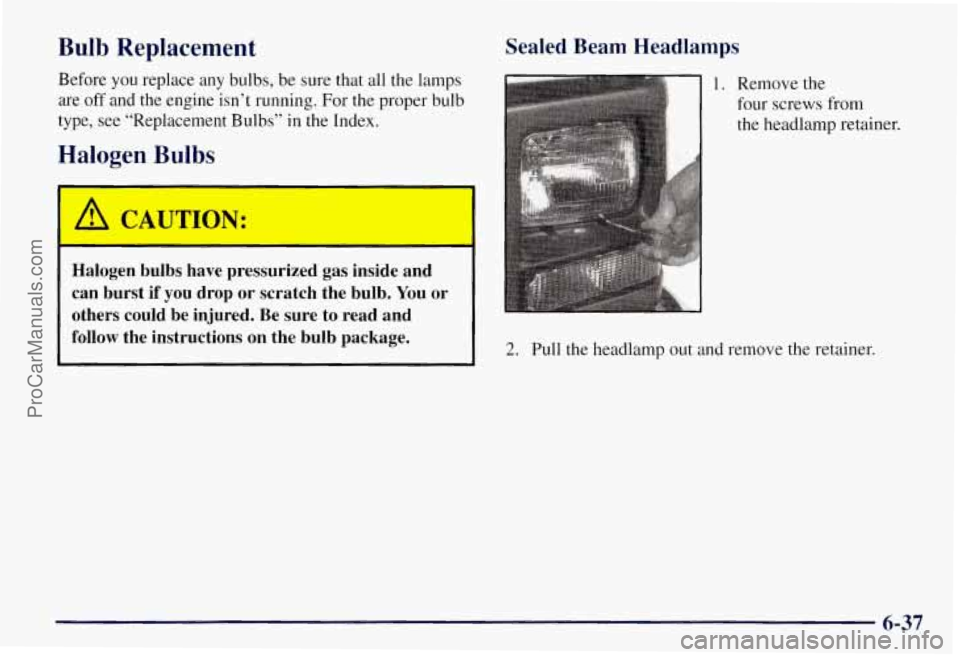
Bulb Replacement
Before you replace any bulbs, be sure that all the lamps
are off and the engine isn’t running. For the proper bulb
-
lbs” in the
type,
see “Replacement Bu
Halogen Bulbs
A CAUTION:
Index.
-
Halogen bulbs have pressurized gas inside and
can burst if
you drop or scratch the bulb. You or
others could be injured. Be sure to read and
follow the instructions on the bulb package.
1
Sealed Beam Headlamps
1. Remove the
four screws from
the headlamp retainer.
2. Pull the headlamp out and remove the retainer.
6-37
ProCarManuals.com
Page 317 of 433
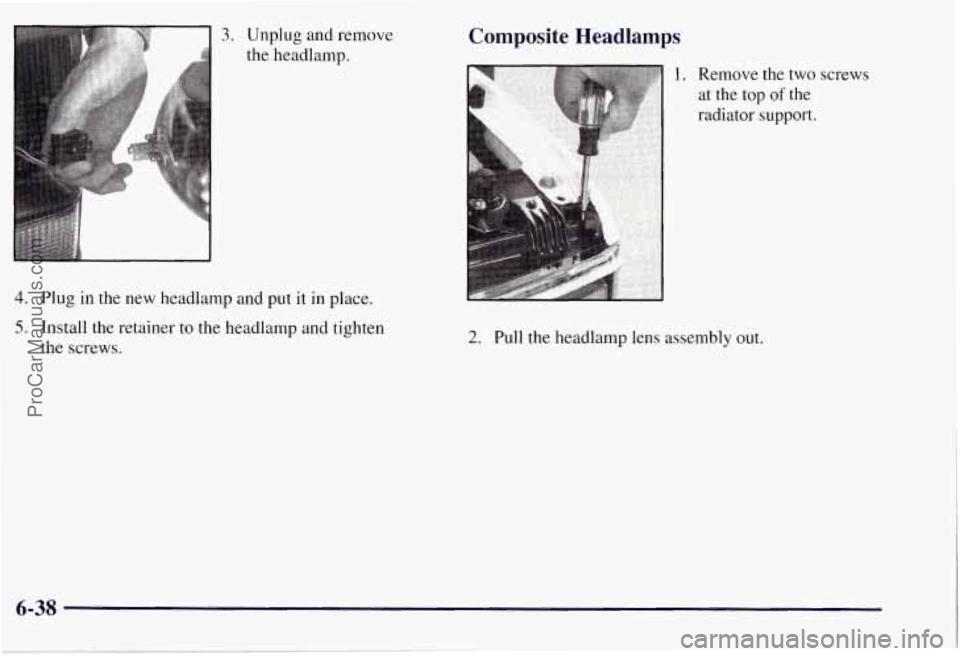
3. Unplug and remove
the headlamp.
4. Plug in the new headlamp and put it in place.
5. Install the retainer to the headlamp and tighten
the screws.
Composite Headlamps
2. Pull the headlamp lens assembly out.
ProCarManuals.com
Page 318 of 433
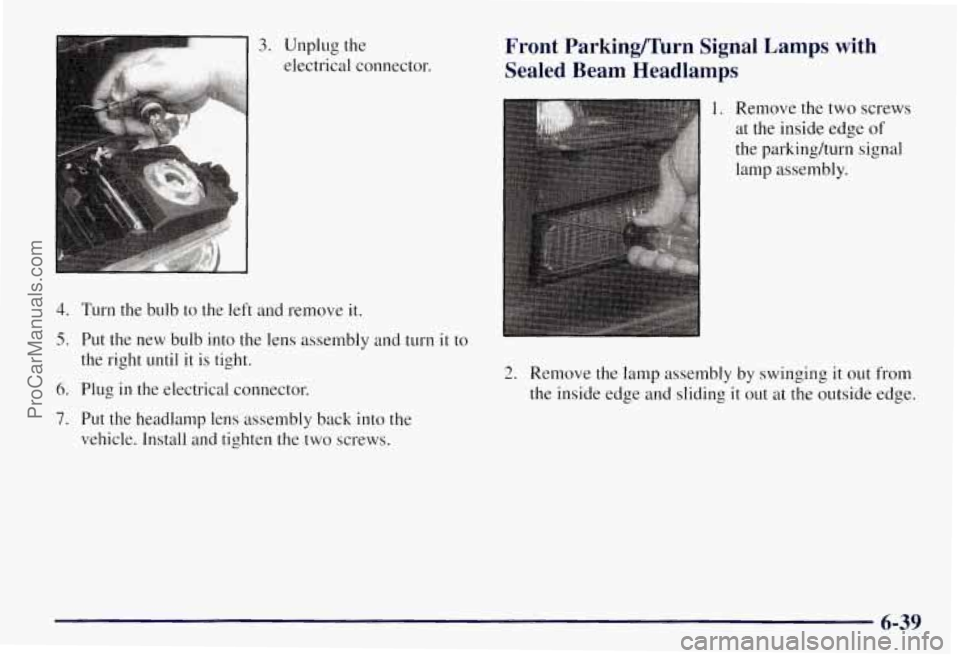
3. Unplug the
electrical connector.
4. Turn the bulb to the left and remove it.
5. Put the new bulb into the lens assembly and turn it to
the right until it
is tight.
6. Plug in the electrical connector.
7. Put the headlamp lens assembly back into the
vehicle. Install and tighten the two screws.
Front Parking/-rn Signal Lamps with
Sealed Beam Headlamps
1. Remove the two screws
at the inside edge of
the parkinghurn signal
lamp assembly.
2. Remove the lamp assembly by swinging it out from
the inside edge and sliding
it out at the outside edge.
6-39
ProCarManuals.com
Page 319 of 433
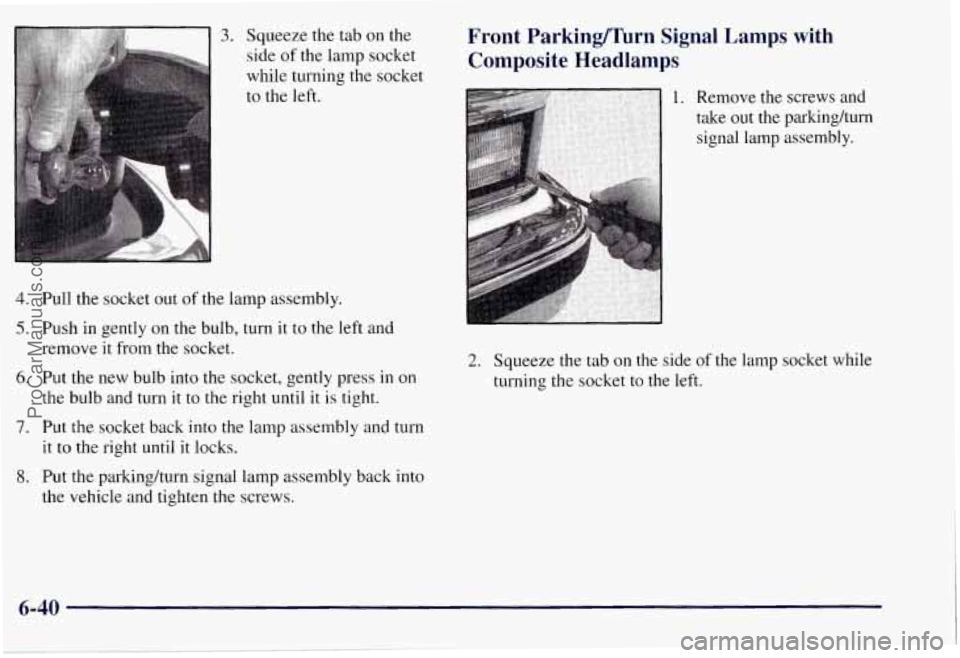
3. Squeeze the tab on the
side of the lamp socket
while turning the socket
to the left.
4. Pull the socket out of the lamp assembly.
5. Push in gently on the bulb, turn it to the left and
remove it from the socket.
6. Put the new bulb into the socket, gently press in on
the bulb and turn
it to the right until it is tight.
7. Put the socket back into the lamp assembly and turn
it
to the right until it locks.
8. Put the parkingkurn signal lamp assembly back into
the vehicle and tighten the screws.
Front Parkinnrn Signal Lamps with
Composite Headlamps
2. Squeeze the tab on the side of the lamp socket while
turning the socket to the left.
ProCarManuals.com
Page 320 of 433
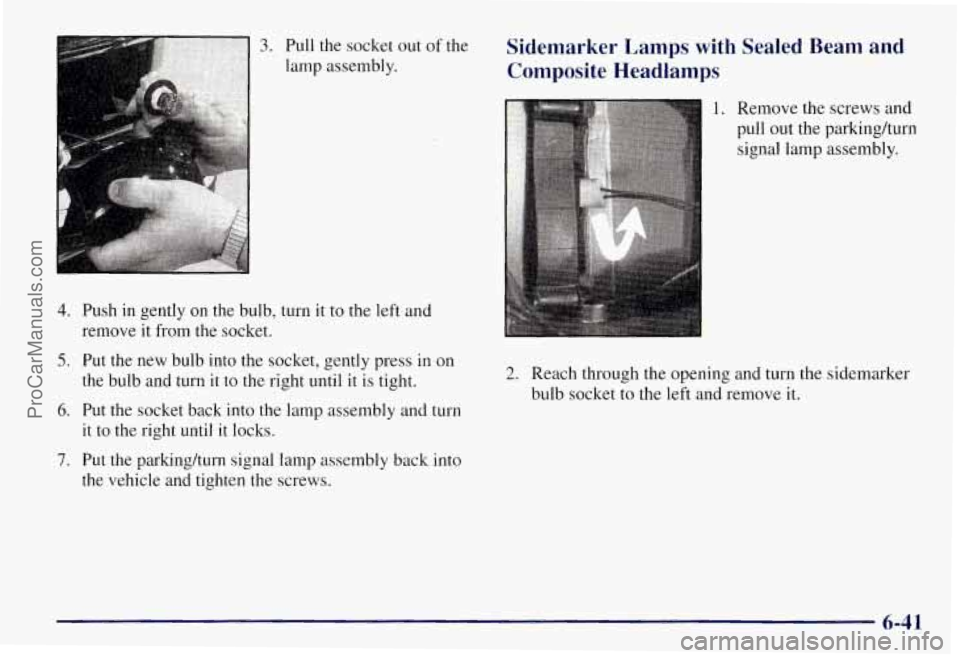
3. Pull the socket out of the
lamp assembly.
4. Push in gently on the bulb, turn it to the left and
remove it from the socket.
5. Put the new bulb into the socket, gently press in on
the bulb and turn it to the right until it is tight.
6. Put the socket back into the lamp assembly and turn
it to the right until it locks.
7. Put the parkinghurn signal lamp assembly back into
the vehicle and tighten the screws.
Sidemarker Lamps with Sealed Beam and
Composite Headlamps
1. Remove the screws and
pull out the parkinghurn
signal lamp assembly.
2. Reach through the opening and turn the sidemarker
bulb socket to the left and remove it.
6-41
ProCarManuals.com